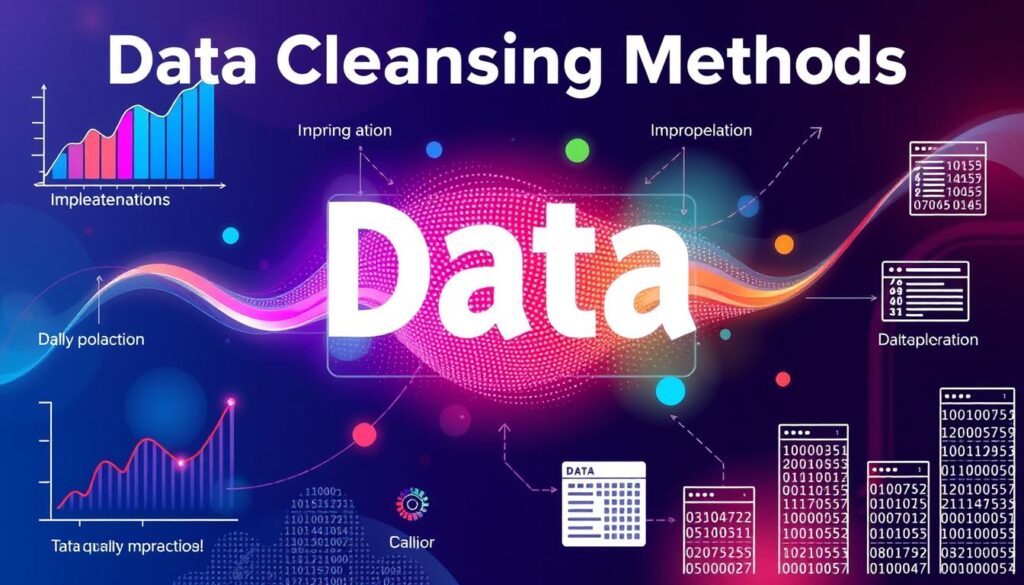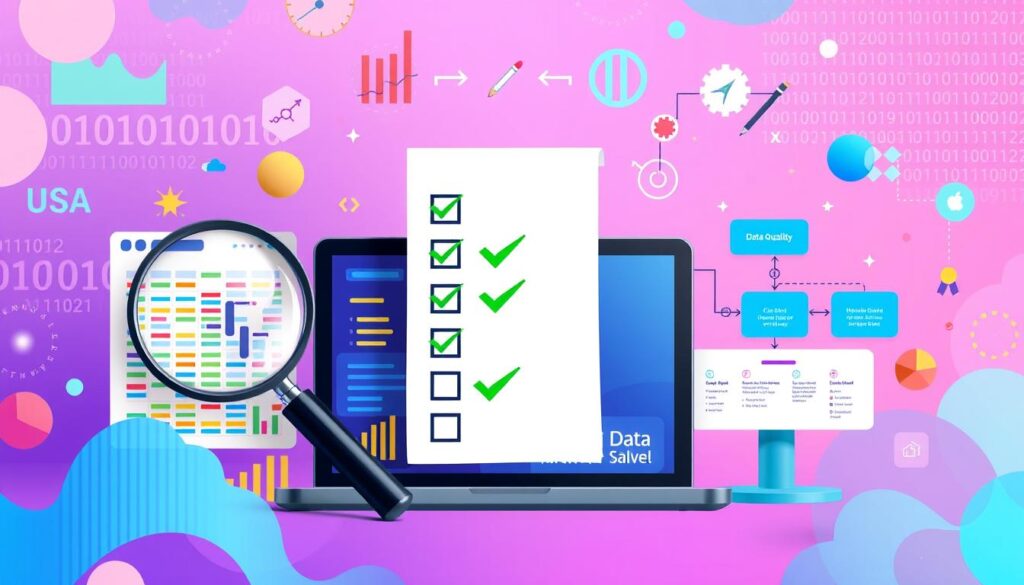As a data analytics pro, I’ve seen how bad data can cost a company up to 20% of its expected revenue. This shows how vital data cleaning is for keeping data reliable and accurate. Fixing bad data later can cost ten times more, about $10. So, cleaning data regularly can save a company a lot of money.
Data cleaning fixes many problems like wrong formatting, spelling mistakes, duplicate records, and missing data. It’s a key step for any business.
By following the best data cleaning practices, companies can make better decisions. This reduces the cost of dealing with wrong data. AI and machine learning help make data cleaning faster and more accurate. We’ll cover the main data cleaning techniques, like removing duplicates, dealing with missing data, and making data formats standard. We’ll also share tips for using these methods in real-world situations.
Key Takeaways
- Master data cleaning is a critical process that involves removing errors, inconsistencies, and inaccuracies from data to ensure that it is reliable and trustworthy.
- Data cleaning techniques can help organizations maintain data integrity and accuracy, avoiding financial repercussions and improving overall operational efficiency.
- AI tools and machine learning algorithms can aid in the data cleaning process, optimizing record deduplication and minimizing reliance on manual methods.
- Best practices for data cleaning include data deduplication, handling missing data, and standardization of data formats.
- Implementing data cleaning techniques can significantly enhance insights that inform decision-making processes, reducing costs associated with managing incorrect data.
- Continuous monitoring of business partner data is essential for reducing implementation effort and maintaining data integrity.
- Organizations that adopt AI-driven referential matching and semantic comparison experience better accuracy in data identification and correction.
Understanding the Importance of Data Cleaning
As a data analyst, I know how vital data cleansing methods are. They help us get accurate and reliable insights. In fact, up to 60-80% of a data analyst’s time goes into cleaning data. This shows how important data scrubbing techniques are for data quality.
Keeping databases in check helps find errors early. This saves a lot of trouble and money later. For example, good data management can cut processing errors by 30%. Also, companies with clean data can be 15% more productive.
Some big pluses of data cleaning are:
- More accurate customer targeting by up to 90%
- Less processing errors by up to 30%
- Up to 15% more productivity
Using the right data cleansing methods and data scrubbing techniques makes data better. This leads to better financial results and performance for companies.
Common Data Quality Issues
Exploring data quality, I’ve found that common problems can really affect data accuracy. These issues come from human mistakes, duplicate data, and different data formats. To fix these, we need good data cleaning and quality improvement methods.
Duplicate records, missing values, and different data formats are big problems. Studies say 20-30% of data errors are due to duplicates. Missing values can be up to 25% of data fields. And, about 15-20% of datasets have inconsistent formatting. Using quality improvement methods can help reduce these issues.
For example, a company can use data validation to keep data accurate. They can set rules for data format and range. This stops bad data from getting in. Also, standardizing data makes it easier to work with. By focusing on data cleaning and quality, companies can make better decisions. Data quality improvement methods can also boost analytics confidence, leading to up to 35% better accuracy.
Good data management means regular checks and using the right tools. This lowers the chance of data errors and improves quality. Companies can then make smarter choices, save money, and grow. With the right approach, data can be a powerful tool for success.
Techniques for Data Deduplication
Data deduplication is key in cleaning data. It removes duplicate records to make data accurate and reliable. By using good data cleaning techniques, businesses can make better decisions and work more efficiently. It’s important for companies to follow best practices for data cleaning, including deduplication.
Data deduplication has many benefits. It can lower storage costs, boost productivity, and help make better data-driven choices. By getting rid of duplicates, companies save space and time on data analysis. It also helps meet compliance rules and improve data management.
Some common ways to do data deduplication include:
- Identifying duplicates using algorithms and matching techniques
- Merging duplicate records to create a single, accurate record
- Using tools and software to automate the deduplication process
By using these methods and following best practices, businesses can make sure their data is accurate and efficient. This leads to better decision-making, more productivity, and better overall performance.
| Technique | Benefit |
|---|---|
| Identifying duplicates | Reduced storage costs |
| Merging duplicate records | Improved productivity |
| Automating deduplication | Enhanced data-driven decision-making |
Handling Missing Data
Dealing with missing data is crucial for keeping data accurate and reliable. One way to handle this is through data scrubbing. This includes imputation, where missing values are replaced with estimated ones. There are many imputation methods, like mean, median, and mode imputation, and even more advanced ones like linear interpolation and KNN imputation.
Some common ways to deal with missing data include:
- Deletion: removing rows or columns with missing values
- Imputation: replacing missing values with estimated ones
- Forward filling: using previous values to fill in missing ones
- Backward filling: using the next valid value to fill in missing ones
Choosing the right technique depends on the data type and the problem at hand. By using these methods, we can make complex data easier to understand. This helps us give our clients valuable insights.

Standardization of Data Formats
When I dive into data cleaning, I see how key it is to standardize data formats. This makes sure our data is both accurate and reliable. We do this by setting clear data entry rules and using tools to transform data. This way, we cut down on errors and boost data quality.
Some main ways to standardize data formats include:
- Creating consistent data entry guidelines to reduce errors and inconsistencies
- Utilizing data transformation tools to convert data into a standardized format
- Implementing data validation rules to ensure data meets specific criteria
Standardizing data formats helps businesses make better decisions and work more efficiently. I stress the need for efficient data cleaning and quality improvement. This is why I urge businesses to focus on standardizing their data.
Also, using tools like data normalization and mapping helps keep data consistent. By documenting our data processes and checking quality metrics, we keep our data accurate and reliable. This is crucial for ongoing data integrity.
| Technique | Description |
|---|---|
| Data Normalization | Reduces data redundancy and complexity |
| Data Mapping | Ensures consistency across various data sources |
| Data Validation | Confirms data meets specific criteria such as formats and patterns |
Data Validation Techniques
Data validation is key to making sure datasets are accurate and reliable. It involves setting up rules to catch errors and inconsistencies. This is crucial for keeping data quality high. By using data cleaning techniques, companies can create a strong validation framework. This is vital for making smart decisions.
Automated validation helps spot errors quickly and efficiently. But, manual checks are also important, especially for complex data. Data profiling is essential too. It helps understand the data’s structure, content, and how it relates to other data.
Some top data cleaning practices include:
- Setting up validation rules to find and fix errors
- Using both automated and manual checks for accuracy
- Doing data profiling to deeply understand the data

By following these data cleaning best practices, companies can keep their data quality high. This is crucial for making informed decisions and achieving business success.
Data Transformation Methods
Exploring data transformation, I see how vital data cleansing methods are. They make sure our data is accurate and trustworthy. The right data scrubbing techniques are key to this transformation.
There are many ways to transform data. Normalization and denormalization are two important ones. Normalization breaks down data into tables to reduce redundancy. Denormalization, on the other hand, combines data from different tables for better query performance.
Data aggregation is another important part of data transformation. It combines data from various sources to give a complete view. Techniques like grouping and summarizing data, and statistical analysis, help achieve this.
Using the right data transformation and data cleansing methods is crucial for businesses. It ensures their data is reliable and consistent. This is essential for making smart decisions. Effective data scrubbing techniques also prevent errors and inconsistencies, which are vital for smooth business operations.
Employing Data Cleaning Tools
Exploring data cleaning, I see how vital efficient data cleaning is. It ensures our data is accurate and reliable. With more data being created, the right tools are key. Data cleaning tools offer ways to improve data quality, helping organizations make better decisions.
Popular tools include OpenRefine and Trifacta. They have features like data profiling and transformation. It’s important to pick a tool that fits your organization’s needs and data type.
When choosing a data cleaning tool, consider these features:
- Data profiling and analysis
- Data transformation and normalization
- Data quality checks and validation
- Integration with other data management tools
Using the right tools ensures your data is accurate and complete. This leads to better decisions and outcomes.
| Data Cleaning Tool | Features | Pricing |
|---|---|---|
| OpenRefine | Data profiling, data transformation, data quality checks | Free |
| Trifacta | Data transformation, data normalization, data quality checks | Commercial |
Best Practices for Ongoing Data Management
Reflecting on my data management experience, I see how key ongoing management is. It’s about regularly checking data, teaching staff about data care, and setting up a data governance plan. These best practices for data cleaning help keep data accurate and trustworthy.
It’s vital to do data audits often. You might do them monthly, quarterly, every six months, or yearly, based on how much data you handle. Also, training staff on data cleaning techniques helps avoid mistakes and ensures data is managed right.
Organizations can also make a data governance framework. This plan outlines how to manage data, making sure everyone knows their part. By sticking to these best practices for data cleaning, companies can keep their data top-notch and make better choices.
- Regular data audits to identify and address data quality issues
- Training staff on data cleaning techniques to prevent data errors
- Creating a data governance framework to outline policies and procedures for data management
By following these best practices, companies can keep their data accurate, reliable, and safe. This supports their goal to grow professional knowledge and use business analytics wisely.
Future Trends in Data Cleaning
The world of data is getting bigger and more complex. Data cleansing methods and data scrubbing techniques are changing fast. They’re using artificial intelligence (AI) and machine learning (ML) to make data cleaning easier.
AI is becoming a big player in data cleaning. It can spot and fix data problems right away. This means less work for humans, like finding duplicates or filling in missing info. It’s expected that AI will help clean data 50% more by 2025, making decisions based on data better and faster.
Machine learning is also getting smarter. It learns from lots of good data to fix common problems. This makes the data more reliable and useful for businesses in healthcare and finance. They’ll get better insights and predictions thanks to AI and ML in data cleaning.


